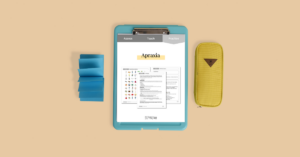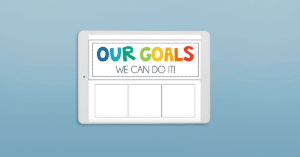If you’re a speech-language pathologist, I am willing to bet you have a student (or 20) with articulation goals on your caseload. With numbers like that, we are writing a lot of articulation goals over the course of the year. This can feel overwhelming, but don’t worry, we’ve got you!
Let’s dive into writing awesome articulation goals for your speech therapy students!
Understanding Typical Speech Sound Development
Before you can determine which speech sound goals to target, it is important to understand typical speech sound development. We don’t want to base all of our recommendations on these norms, but they are something to have in your toolbox as you evaluate and write your speech articulation goals.
Articulation Norms
Research has shown there is an age of acquisition for speech sound development. Click here for a free cheat sheet for articulation norms, and even more information on speech sound development based on age of acquisition.
Contextual Factors
There are other factors to consider when diagnosing a student with a speech sound disorder, such as students’ capacity for speech perception and production, overall intelligibility, stimulability, phonological awareness, academic/social impact, and student/family insights (Storkel, 2019).
Dialectal Considerations
Consider the factors for culturally/linguistically diverse speakers. Click here for ASHA’s list of Phonemic Inventories and Cultural and Linguistic Information Across Languages.
What is the Difference Between an Articulation Disorder and a Phonological Disorder?
According to ASHA, articulation disorders are speech sound errors that occur due to difficulty producing the sound on a motoric level, and phonological disorders occur in students who linguistically have difficulty organizing sounds. In IEP meetings, I would often explain that a speech student with an articulation disorder has a difficult time using articulators to produce the sounds, whereas phonological disorders can be a “pattern of errors” such as stopping, fronting, etc.
Determining whether our student has an articulation disorder or a phonological disorder is an important distinction, as it can impact the approach we choose and how we write our goals.
Here is a list of ways to distinguish between articulation disorders and phonological disorders:

Articulation Disorders:
🗣️ Errors at the phonetic/motoric level (difficulty producing sounds)
🗣️ 1-2 errors that are substituted or distorted, typically in a predictable way
🗣️ More common in older students
Phonological Disorders:
🗣️ Errors at the phonemic/linguistic level (difficulty organizing sounds)
🗣️ Groups of sounds or types of syllable structures are omitted, swapped, or simplified, which can be consistent or inconsistent
🗣️ More common in younger students
Write SMART Goals to Help Your Speech Students and Make your IEP Articulation Goals as Clear as Possible
Before we get into choosing targets for our speech articulation goals, let’s start with a refresher on how to write SMART articulation goals.
S.M.A.R.T. articulation Goals are:
S – Specific: Is your articulation goal specific? Did you talk about the setting? Are you putting too many things in one goal?
M – Measurable: Can you measure this articulation goal with data? Consider a rubric for some of those harder-to-measure speech therapy goals.
A – Attainable: Is this articulation goal attainable in a year for this particular student? Goals are individual, make sure it’s feasible for this student.
R – Realistic: Is this articulation goal something that will generalize to the classroom/school environment and help the student succeed at school? Have you considered the whole EBP triangle with research, clinical judgment, and information from the student and their family?
T- Timely: Can the student achieve the speech articulation goal in the amount of service time you are recommending for the IEP?
5 Factors to Consider When Writing Articulation Goals
1. Complete a comprehensive formal and informal articulation evaluation. (Be sure to target any other areas of concern.)
2. Consider the impact the student’s speech articulation has on the student. Be sure to get feedback from the students, teachers, and parents. If possible, you can observe the student in different settings.
3. If they already qualify for speech therapy services, review data from your student’s speech sessions.
4. Identify your student’s strengths, and build from there.
5. Based on your evaluations, feedback, and observations, identify your student’s articulation challenges.
Articulation Goals for Speech-Language Pathologists & Articulation Goal Bank
Congratulations! You’ve performed a comprehensive speech articulation evaluation and determined your student qualifies for speech therapy. Now it is time to write your student’s articulation goals.
SLP Now’s Speech Therapy Articulation Goal Bank
If you’re wondering where you should start for your articulation goals, the SLP Now Goal Bank is full of articulation goal ideas that can help you create individualized speech therapy goals based on your student’s strengths and needs.
Examples of Goal Targets and Goal Levels for Articulation Goals
When writing your speech articulation goals for your student’s IEP, you want to determine which speech sound you want your student to target, as well as which level they will be targeting the goal.
You will choose your goal targets based on the results of your evaluation, goal data, etc. Examples of potential articulation goal targets include (but are definitely not limited to) targeting speech sounds such as /r/, /k/, /l/, /s/, /f/, /p/, and /t/.
After choosing the goal target, we will want to be more specific and list out which level we want our student to achieve their articulation goal by the end of the IEP period. Examples of goal levels for your articulation goals can include the following: in isolation, in syllables, in all positions of words, in phrases, in structured sentences, in spontaneous sentences, in oral reading tasks, in structured conversation, in spontaneous speech
3 Examples of Speech Articulation Goals for IEPs
Goal 1: By next IEP period, given a word or image, Student will increase intelligibility by producing /l/ at the beginning of words, in the speech classroom, given no more than 1 verbal prompt, with 75% accuracy across 3 consecutive sessions.
Goal 2: By next IEP period, given a word or image, Student will increase intelligibility by producing /f/ across all positions of words at the independent sentence level, in the speech classroom, given no more than 1 verbal prompt, with 80% accuracy across 3 consecutive sessions.
Goal 3: By next IEP period, during structured conversational tasks, Student will produce /r/ across all positions of words in spontaneous speech, in the speech classroom, given no more than 1 visual prompt, with 70% accuracy across 3 consecutive sessions.
Head to the SLP Now Goal Bank to brainstorm articulation IEP goal targets and levels for your speech therapy IEP goals!
What are the Different Approaches for Speech Sound Disorders?
You’ve written awesome speech therapy goals for your articulation students, and now it is time to start treatment.
For now, I will list the different speech sound disorder approaches, as well as a short description of each. However, SLP Now has an article that provides an in-depth breakdown of articulation approaches for your students.
Traditional Articulation Therapy
Traditional Articulation Therapy uses the developmental approach to target selection, where speech sounds are targeted based on order of acquisition (Tambyraja, 2014).
Complexity Approach
The Complexity Approach is a non-developmental approach to target selection, where sounds are targeted based on the level of complexity. Research shows that children acquire skills needed for less complex sounds while working on complex sounds, and that articulatory skills trickle down to foundational sounds (Strokel, 2017).
Cycles Approach
For the Cycles Approach, Phonological patterns are treated in cycles of 5 to 16 weeks. The error patterns are targeted in each cycle (Hassink, 2010).
References
Hassink, J. M., & Wendt, O. (2010). Remediation of Phonological Disorders in Preschool Age Children: Evidence for the Cycles Approach. EBP Briefs, 5(2), 1-7.
“Speech Sound Disorders-Articulation and Phonology.” ASHA, www.asha.org/practice-portal/clinical-topics/articulation-and-phonology/. Accessed 25 Sep. 2023.
Strokel, H. L. (2017). The Complexity Approach to Phonological Treatment: How to Select Treatment Targets. Language, Speech, and Hearing Services in Schools.
Storkel, H. L. (2019) Using Developmental Norms for Speech Sounds as a Means of Determining Treatment Eligibility in Schools. Perspectives of the ASHA Special Interest Groups, Vol. 4, 67-75.
Tambyraja, S. R., & Dunkle, J. T. (2014). Target Selection in Speech Therapy: Is a Non-Developmental Approach More Efficient Than a Developmental Approach? EBP Briefs, 8(5), 1-9.




Reader Interactions